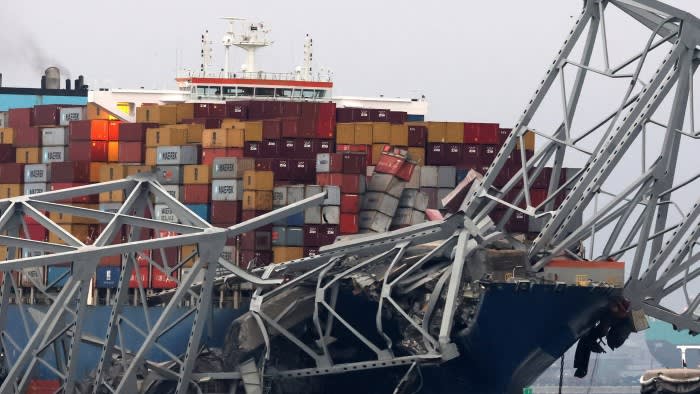Unlock the Editor’s Digest for free
Roula Khalaf, Editor of the FT, selects her favourite stories in this weekly newsletter.
Carmakers are preparing for months of lower sales as they reroute shipments away from Baltimore following the collapse of the Francis Scott Key Bridge, while insurers have warned of multibillion-dollar claims stemming from the disaster.
Manufacturers are already diverting deliveries and exports to other sites after the closure of Baltimore’s port, which is the largest car-handling terminal in the US and used by almost every major manufacturer.
But they expect other bottlenecks to force delays at ports including Charleston, New Jersey and New York due to increased traffic, and a potential shortage of dockside vehicle handlers.
“There will undoubtedly be constraints as everyone moves to alternative routes,” said a director at one European carmaker.
The warnings of bottlenecks come as US authorities assess the scale of the disaster, which saw the highway bridge collapse after being struck by a container ship in the early hours of Tuesday morning. Six people are thought to have died in the accident.
Baltimore is the US’s largest car import port and 80 per cent of cars imported in 2023 were at terminals behind the collapsed bridge, according to Clarksons Research.
Insurance groups are also bracing for billions of dollars of estimated losses stemming from the accident, with reinsurers likely to foot the bill in a legal fallout expected to last for years.
Mediterranean Shipping Company, operator of the world’s largest container ship fleet, has warned customers it will be months before operations at the Port of Baltimore return to normal.
“We . . . have no choice but to omit Baltimore from all our services for the foreseeable future, until the passage to port is reopened and declared safe,” the company said in an advisory to customers. “We expect this to take several months.”
One car group that exports to the US through the Baltimore port said it was possible that the collapse would measurably affect its US sales numbers in the coming months.
They warned it was too early to know for sure how severe the bottlenecks would be elsewhere as all big importers adjust their supply routes at the same time.
There are also concerns about skills shortages.
“The main issue with rerouting to alternative ports is the lack of skilled labour and specialist equipment in handling the cars,” said Dominic Tribe, an automotive analyst at Vendigital. “Baltimore has a few auto processors on site that help add features and can cover minor repairs.”
Philippe Houchois, analyst at Jefferies, said carmakers expected a “slowdown rather than interruption” to deliveries.
Baltimore is a popular port for carmakers because it is far inland, saving logistics costs, and connected to two direct rail links.
Several European carmakers including Volkswagen and BMW are unaffected because Baltimore’s Sparrows Point terminal, on the site of an old steelworks, is east of the bridge and remains open.
VW, which shipped about 100,000 vehicles including Porsche, Audi and Bentleys through the port last year, said it did “not anticipate any impact on vessel operations but there may be trucking delays as traffic in the area will be rerouted”.
Mercedes said the Baltimore port was one of multiple ports used by the company along with those in New Brunswick, New York and Charleston, South Carolina. “We are in close contact with our logistics service providers . . . we have several options available within our flexible supply chain network,” said a spokesperson.
BMW said its automotive terminal in Baltimore, which it uses for imports, remained accessible. It makes its X5 sport utility vehicle at the Spartanburg plant in South Carolina, and exports them through that state’s Charleston port.
The potential insurance claim stemming from the accident could reach $1bn to $3bn, analysts at Barclays wrote in a note on Wednesday. AM Best, a specialist insurer rating agency, also said the bill would probably run into the billions.
Most of it is expected to flow through to the ship’s reinsurers, which is spread among a large group including Axa XL, a division of the French insurer. Axa said any impact would be “non-material” at group level.
Claims could span property and cargo damage, third-party liabilities and business interruption, said Mathilde Jakobsen, AM Best senior director, and would “serve to add to the increasing challenges in reinsurance availability”. A pullback from the reinsurance sector in the past couple of years has piled pressure on primary insurers and the people and businesses they serve.
Insurers are rushing to get their head around the size and variety of the potential claims. President Joe Biden has said the federal government will fund the bridge’s reconstruction, adding that it was “not going to wait” for compensation from the private sector.
Julien Horn, a partner at insurance broker McGill & Partners, said the potential liabilities “go beyond the rebuilding of the bridge and will need to consider removing the bridge debris” from the ship and river. It would take “years to fully comprehend” the economic disruption to people and businesses in the local region, he said.
